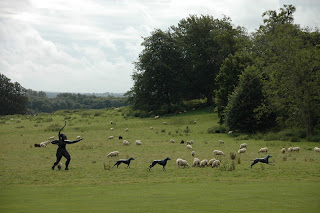We
left the continent via the Le Havre – Portsmouth ferry so we could spend some
time with Sue and Martin. They were keen to show us their backyard. The view of
Le Havre was diverse but unfortunately dominated by some pretty unattractive
post war flats.
As we were a late arrival the first night was spent in the
caravan and we then moved into Sue and Martin’s one bedroom flat (they
relocated to Martin’s Mum Beryl’s house). Martin gave me a tour of Poole
harbour – it is clear that the GFC has not affected everyone with the boat
manufacturer Sunseeker very busy with many expensive boats under construction –
all the sheds (and there were a lot of them) were full.
Poole’s harbour is the second biggest in area in the world
(Sydney being the biggest). The calmer upstream waters require passing through
an old lift bridge. As this disrupts traffic on a regular basis a new bridge
was built further upstream so that traffic could always move across (as long as
the drivers knew the timetable).
The
new bridge is a wonderful design with a very slim and unobtrusive low profile
when down
But
when up is really impressive and aptly named the twin sails bridge.
A little later in the day we travelled to Wareham where a
small church sits atop a Saxon wall.
The paintings in here date back to the 12th
Century and are of Martin of Tours (born 316 A.D.)
However, the church is also famous for an unwanted, by
Westminster Abbey, effigy of Lawrence of Arabia. He lived in the area and the
church snapped up the opportunity. Nearby (but not in the church cemetery) is
his grave (16 August 1888 – 19 May 1935). (Someone has recently added some
stones saying Happy Birthday.)
And further up the road is St Nicholas church where he was
buried. This is a beautiful little church which is unusual in that its windows
are etched glass (the original windows being blown out by a second world war
bomb). (If you blow up the picture the windows can be seen.)
We had lunch in a cafeteria housed in the old school. Pride
of place is the carriage that carried Lawrence’s coffin.
Our education by Martin continued with the introduction to a
Ha Ha. This is a ditch with a wall and rather like a small moat prevents access
from one side. Here there is a gate through the Ha Ha to enable the Lord of the
Manor access to the church. It is important that the upper class do not have to
share the same path as the unwashed.
In our weaving through the countryside we crossed an old
(fixed) bridge. In the middle is a plaque that reads “Any person wilfully
injuring any part of this County Bridge will be guilty of Felony and upon
conviction liable to be Transported for life”. This is why Australia suffers
from graffiti on many bridges.
Helen had decided we should pretend to be upper class and
had booked us into Glyndebourne. This is a country mansion near Brighton where
the owners were Opera tragics. They built a stage for opera and now host
several shows during the summer season. It is a black tie affair and the 1.5
hour interval enables guests to enjoy a wonderful dinner. We saw the Fairy
Queen (based on Shakespeare’s Midsummer Nights dream and using Purcell’s music
and words). It was a wonderful mix of theatre, dance and opera. We were not
allowed to photograph the show but here we are at dinner.
We were the last to finish dinner – but part two was not
started until we returned.
The following day we took the opportunity to return and
visit the grounds. There are some great sculptures. This one is on the other
side of a Ha Ha (note the line of the two grass areas) which keeps the sheep
out and gives unrestricted views (which would not be the case with a fence).
The sculptures were appreciated by the locals. This one
bleated “man this is really living”.
This is the Ha Ha from a different angle.
We then moved from this tranquil setting to the mayhem of
Brighton during a Bank Holiday. Here Kensington Gardens and Sydney Street were
teeming with people.
We escaped some of the crowds with a trip to the pavilion
built by the extravagant George IV. The Asian influence is apparent throughout.
Queen Victoria subsequently decided the pavilion was not suitable for raising
children and sold the palace to the people of Brighton who continue to own it
today.
The other great attraction is Brighton pier (there were two
but one burnt down). It looks peaceful from this view but close up it was a
packed with people, re-born Elvis Presley, rides, chips, beer and unrelenting
noise. Worth a visit but not something that needs repeating!
This ended our European touring for 2012 and after
reluctantly packing up the ‘van and car we headed off for New York.





















No comments:
Post a Comment